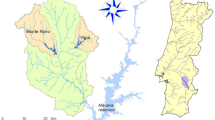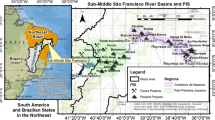Abstract
Integrated water planning and management face multiple challenges, among which are the competing interests of several water-using sectors and changing climatic trends. This paper presents integrated and non-integrated climate-environment-water approaches for reservoir operation, illustrated with Karkhe reservoir, Iran. Reservoir operation objectives are meeting municipal, environmental, and agricultural water demands. Results show the integrated approach, which relies on multi-objective optimization of municipal, environmental, and agricultural water supply, improves the municipal, environmental, and agricultural objectives by 70, 32, and 65% compared with the objectives’ values achieved with the non-integrated approach, which implements a standard operating policy.







Similar content being viewed by others
References
Abrahão, R., García-Garizábal, I., Merchán, D., & Causapé, J. (2015). Climate change and the water cycle in newly irrigated areas. Environmental Monitoring and Assessment, 187, 22.
Aiwen, Y. (2000). Impact of global climate change on China’s water resources. Environmental Monitoring and Assessment, 61(1), 187–191.
Conly, F. M., & Kamp, G. (2001). Monitoring the hydrology of Canadian prairie wetlands to detect the effects of climate change and land use changes. Environmental Monitoring and Assessment, 67(1–2), 195–215.
Croke, B.F.W. and Jakeman, A.J. (2008). "Use of the IHACRES rainfall-runoff model in arid and semi arid regions." Workshop of the National Institute of Hydrology, Roorkee, India, 28 February- 5 March.
Deb, K. (2001). Multi-objective optimization using evolutionary algorithms. England: Wiley.
Fallah-Mehdiour, E., Bozorg Haddad, O., Rezapour Tabari, M. M., & Marino, M. M. (2012). Extraction of decision alternatives in construction management projects: application and adaptation of NSGA-II and MOPSO. Expert Systems with Applications, 39, 2794–2803.
Fujino, J., Nair, R., Kainuma, M., Masui, T., & Matsuoka, Y. (2006). Multi-gas mitigation analysis on stabilization scenarios using aim global model. Energy Journal, 343–353.
Goodarzi, M., Abedi-Koupai, J., Heidarpour, M., & Safavi, H. M. (2016). Evaluation of the effects of climate change on groundwater recharge using a hybrid method. Water Resources Management, 30(1), 133–148.
Krol, M. S., Vries, M. J., Oel, P. R., & Araújo, J. C. (2011). Sustainability of small reservoirs and large scale water availability under current conditions and climate change. Water Resources Management, 25(12), 3017–3026.
Krysanova, V., Dickens, C., Timmerman, J., Varela-Ortega, C., Schlüter, K., Roest, K., Huntjens, P., Jaspers, F., Buiteveld, H., Moreno, E., Pedraza Carrera, J., Slámová, R., Martínková, M., Blanco, I., Esteve, P., Pringle, K., Pahl-Wostl, C., & Kabat, P. (2010). Cross-comparison of climate change adaptation strategies across large river basins in Europe, Africa and Asia. Water Resources Management, 24(14), 4121–4160.
Mujumdar, P. P. (2013). Climate change: a growing challenge for water management in developing countries. Water Resources Management, 27(4), 953–954.
Rashid, M. U., Latif, A., & Azmat, M. (2018). Optimizing irrigation deficit of multipurpose cascade reservoirs. Water Resources Management, 32(5), 1675–1687.
Riahi, K., Rao, S., Krey, V., Cho, C., Chirkov, V., Fischer, G., Kindermann, G., Nakicenovic, N., & Rafaj, P. (2011). RCP 8.5- a scenario of comparatively high greenhouse gas emissions. Journal of Climatic Change, 33–109.
Sarzaeim, P., Bozorg-Haddad, O., Fallah-Mehdipour, E., & Loáiciga, H. A. (2017a). Environmental water demand assessment under climate change conditions. Environmental Monitoring and Assessment, 189–359.
Sarzaeim, P., Bozorg Haddad, O., Fallah-Mehdipour, E., & Loáiciga, A. H. (2017b). Climate change outlook for water resources management in a semiarid river basin: the effect of the environmental water demand. Environmental Earth Sciences, 76, 498.
Sarzaeim, P., Bozorg Haddad, O., Fallah-Mehdipour, E., Zolghadr-Asli, B., & Loaciaga, A. H. (2018). Optimization of run-of-river hydropower plant design under climate change conditions. Water Resources Management, 32(12), 3919–3934.
Shiau, J. T. (2003). Water release policy effects on the shortage characteristics for the Shihmen Reservoir system during droughts. Water Resources Management, 17(6), 463–480.
Shiau, J. T., Hung, Y.-N., & Sie, H.-E. (2018). Effects of hedging factors and fuzziness on shortage characteristics during droughts. Water Resources Management, 32(5), 1913–1929.
Tennant, D. L. (1976). Instream flow regimens for fish, wildlife, recreation and related environmental resources. Fisheries, 1(4), 6–10.
Thomson, A. M., Calvin, K. V., Smith, S. J., Page Kyle, G., Volke, A., Patel, P., Delgado-Arias, S., Bond-Lamberty, B., Wise, M. A., Clarke, L. E., & Edmonds, J. A. (2011). RCP 4.5: a pathway for stabilization of radiative forcing by 2100. Journal of Climatic Change, 77–109.
Tramblay, Y., Jarlan, L., Hanich, L., & Somot, S. (2018). Future scenarios of surface water resources availability in North African dams. Water Resources Management, 32(4), 1291–1306.
Van-Vuuren, D., Edmonds, J., Kainuma, M., Riahi, K., Thomson, A., Hibbard, K., Hurtt, G., Kram, T., Krey, V., Lamarque, J. F., Masui, T., Meinhausen, M., Nakicenovic, N., Smith, S., & Rose, S. K. (2011). The representative concentration pathways: an overview. Journal of Climate Change, 109, 5–31.
Veijalainen, N., Dubrovin, T., Marttunen, M., & Vehviläinen, B. (2010). Climate change impacts on water resources and lake regulation in the Vuoksi Watershed in Finland. Water Resources Management, 24(13), 3437–3459.
Wayne, G.P. (2013). "The beginner’s guide to representative concentration pathways." Skeptical Science.
Weyant, J., Azar, C., Kainuma, M., Kejun, J., Nakicenovic, N., Shukla, P.R., Rovere, E-L., and Yohe G. (2009). Report of 2.6 versus 2.9 watts/m2 RCPP evaluation panel. Geneva: IPCC Secretariat.
Wilby, R. L., Dawson, C. W., & Barrow, E. M. (2002). SDSM—a decision support tool for the assessment of regional climate change impacts. Environmental Modelling & Software, 17(2), 147–159.
Wilby, R.L. and Harris, I. (2006). A Framework for Assessing Uncertainties in Climate Change Impacts: Low-Flow Scenarios for the River Thames, UK. Water Resources Research, 42, W02419.
Xu, C.-Y. (2000). Modelling the effects of climate change on water resources in central Sweden. Water Resources Management, 14(3), 177–189.
Yan, D., Yao, M., Ludwig, F., Kabat, P., Huang, H. Q., Hutjes, R. W. A., & Werners, S. E. (2018). Exploring future water shortage for large river basins under different water allocation strategies. Water Resources Management, 1–16.
Zolghadr-Asli, B., Bozorg Haddad, O., & Chu, X. (2019). Effects of the uncertainties of climate change on the performance of hydropower systems. Journal of Water and Climate Change, 10(3), 591–609.
Funding
This research received financial support from the National Elites Foundation and Iran’s National Science Foundation (INSF).
Author information
Authors and Affiliations
Corresponding author
Ethics declarations
Conflict of interest
The authors declare that they have no conflict of interest.
Additional information
Publisher’s note
Springer Nature remains neutral with regard to jurisdictional claims in published maps and institutional affiliations.
Rights and permissions
About this article
Cite this article
Fallah-Mehdipour, E., Bozorg-Haddad, O. & Loáiciga, H.A. Climate-environment-water: integrated and non-integrated approaches to reservoir operation. Environ Monit Assess 192, 60 (2020). https://doi.org/10.1007/s10661-019-8039-2
Received:
Accepted:
Published:
DOI: https://doi.org/10.1007/s10661-019-8039-2




